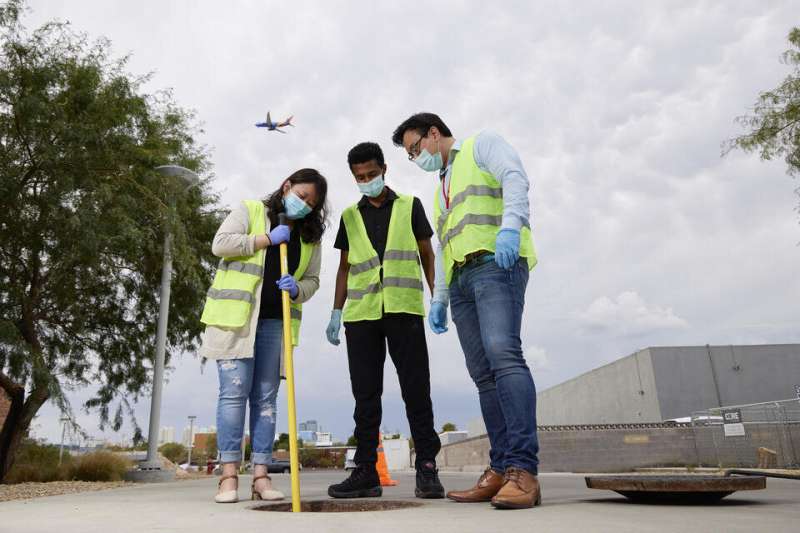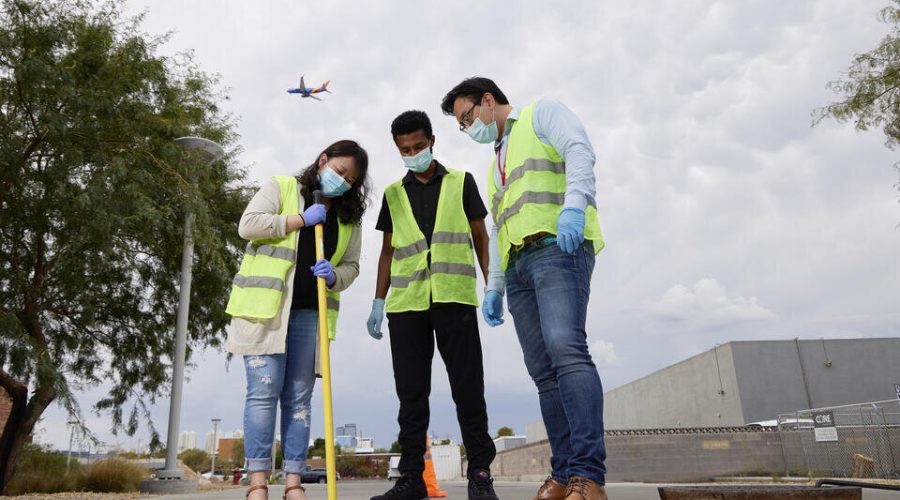How highly mobile populations can skew local COVID-19 wastewater trends

If you thought the waters of data-driven research couldn’t get any murkier, you haven’t met the team of scientists studying our sewage.
Wastewater surveillance has been used throughout the COVID-19 pandemic in Las Vegas and in communities nationwide to help gauge infection levels in local populations. Testing of this kind has an added advantage in that signatures from the virus, or emerging variants of concern, can be detected in wastewater up to weeks before appearing in clinical data—in a way foreshadowing what’s to come.
A new study published Feb. 23 in the medical journal JAMA Network Open argues that municipalities with high numbers of tourists or commuters should take extra consideration when generalizing community-wide wastewater trends, as overall numbers can be skewed by these highly mobile groups.
A research team from UNLV and the Southern Nevada Water Authority (SNWA) began collecting weekly samples in March 2020, eventually including seven wastewater treatment plant locations that serve the vast majority of Southern Nevada’s roughly 2.8 million residents. They also collected wastewater from a manhole serving the Las Vegas Strip—a corridor dense with tourism that attracts hundreds of thousands of weekly visitors.
Researchers wanted to better understand visitor impacts on virus levels in Southern Nevada wastewater as a means of estimating the true incidence of COVID-19 in the local community. Sample collection and analysis covered the period of Nevada’s stay-at-home order in 2020 and the return of pre-pandemic visitor numbers to the region in 2021 and 2022, which gave researchers a unique opportunity to assess visitor impact on overall wastewater trends.
Using the rise of the omicron BA.1 variant in late 2021, researchers determined that visitors contributed more than 60% of the viral load to the largest wastewater treatment plant in Southern Nevada—one that serves both the tourist corridor and a large portion of the local population. The variant was first detected in a manhole serving the Las Vegas Strip on Dec. 7, 2021, a week before it was clinically confirmed locally or detected at any of the wastewater treatment plants. It then became the dominant variant at the wastewater treatment plant serving the tourist corridor, followed by all other treatment plants in Southern Nevada. Researchers leveraged this progression to quantify the disproportionate impact of visitors on the wastewater data.
Researchers argue that, if not accounted for, this influx of viral load from visitors can overinflate wastewater-derived infection estimates for the local community. To account for this, adjustments need to be made when folding in results from visitor-dominated sampling sites with others in the region.
“Wastewater surveillance is a valuable tool that provides time-sensitive insight into emerging disease trends in a community,” said study co-corresponding author Edwin Oh, a researcher with UNLV’s Kirk Kerkorian School of Medicine and director of the university’s Neurogenetics and Precision Medicine Laboratory. “But this research shows that visitor impacts, if not adjusted, can disproportionately affect overall estimates of infection burden.”
Oh notes that while visitor contributions can skew estimates, they can also serve as an early warning signal for local transmission.
“In the case of omicron, initial detection in wastewater foreshadowed this variant’s introduction into the local community and the rapid onset of infections throughout Southern Nevada,” Oh said. “This suggests wastewater surveillance is an important tool that should be used in conjunction with traditional clinical surveillance when estimating overall disease burden.”
Study co-corresponding author Daniel Gerrity, principal research microbiologist at SNWA, also confirmed the value of this tool for public health officials and policy makers but added a note of caution when drawing conclusions from wastewater surveillance data.
“People can shed the virus for weeks following an infection so our study does not necessarily indicate that visitors were transmitting the virus—only that they had previously been infected and were still shedding the viral genetic material into the wastewater,” Gerrity said.
The study, “Detection of the Omicron BA.1 Variant of SARS-CoV-2 in Wastewater from a Las Vegas Tourist Area” was published Feb. 23 in the journal JAMA Network Open.
More information:
Van Vo et al, Detection of the Omicron BA.1 Variant of SARS-CoV-2 in Wastewater From a Las Vegas Tourist Area, JAMA Network Open (2023). DOI: 10.1001/jamanetworkopen.2023.0550
Journal information:
JAMA Network Open
Source: Read Full Article
